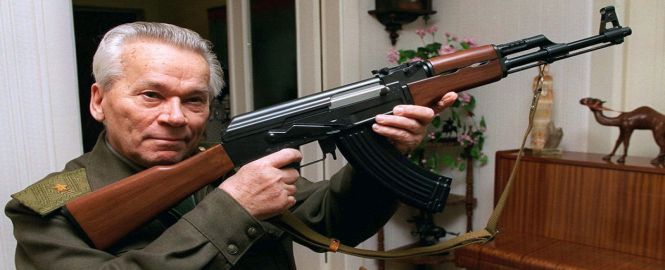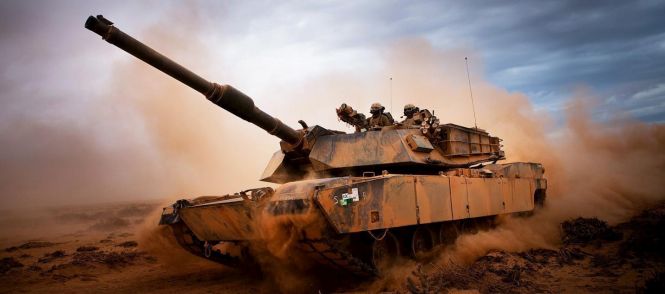
Time and again it's the same. A lone gunman or a small group of killers with rifles commits spectacular crimes that seize the attention of the world.
The list reaches back decades: the killing of Israeli athletes at the Munich Olympics in 1972; the school takeover in Beslan, Russia, in 2004; the attacks in Mumbai, India, in 2008; the mall assault in Nairobi, Kenya, in 2013; the killing of more than 100 people in Paris in 2015.
Often the rifles are variants of the AK-47, the world's most abundant firearm, an affordable and simple-to-use assault rifle of Soviet lineage that allows a few people to kill scores and menace hundreds, and fight head-to-head against modern soldiers and police forces.
In recent years they have also been descendants of the AR-15, the US military's response to the Kalashnikov's spread. Semi-automatic versions of the AR-15 were used by sympathizers of the Islamic State in San Bernardino, California, in 2015, and a Mini-14 and an MCX, rifles that fire the same cartridge as the AR-15 and compete with it for market share, were used in the mass shootings in Norway in 2011 and in Orlando, Florida, in June.
In the hands of terrorists, military-style rifles have repeatedly been used for swiftly killing on a large scale. How did the Kalashnikov - a disruptive technology that flooded the world almost three generations ago and still retains an outsize role in organized violence - become such a ready amplifier of evil and rage? In what ways did it drive the AR-15 and its competitors to such prominence, too?
A Cold War Product

Maschinenpistole 44 (StG 44) or Sturmgewehr 44
The answers reach to the years immediately after World War II, when the Soviet Union was developing multiple weapons for multiple roles. As scientists worked on nuclear arms that would freeze borders under the fear of total war, teams of gunsmiths and engineers set out in a contest to design a conventional weapon - a rifle - that would combine the rapid-fire ferocity of machine guns with the portability of lighter-weight arms. The weapon was to be a conceptual copy of Nazi Germany's sturmgewehr.
In the evaluations and field trials that followed, Senior Sgt. Mikhail T. Kalashnikov, a wounded veteran of tank warfare, was credited with a prototype for a medium-powered rifle capable, like the sturmgewehr, of both automatic and semi-automatic fire.
The AK-47, with an effective range beyond the length of a pair of football fields, was accepted in 1947. A few years later, a lighter and easier-to-manufacture update, the AKM, entered mass production and was on its way to becoming the standard rifle for almost all communist ground forces.
Unpacking Its Appeal

Mikhail Kalashnikov the creator of the AK-47 Assault Rifle
The Kalashnikov line was shorter and lighter than traditional rifles, inexpensive to manufacture, built for durability and extraordinarily reliable. With few moving parts, and a design that made its disassembly and reassembly almost intuitive, its basics could be mastered in very little time.
The cartridges were smaller than traditional rifle cartridges, which meant that a fighter with a Kalashnikov could carry more ammunition and be more deadly. Medium-power cartridges also meant the weapon had little recoil, allowing trainees to learn marksmanship with relative ease.
The Kalashnikov's physical characteristics alone do not explain its prominence. The vast scale of rifle and ammunition manufacture in mammoth arms plants drove the Kalashnikov to its status as one of the most readily identifiable objects in the world.
Soviet production began in the 1940s before expanding to the vassal states of the Warsaw Pact and to China, North Korea, Yugoslavia and beyond. Tens of millions of the rifles were churned out in planned economies, whether they were needed or not.
A constellation of ammunition plants ensured ready supplies. More state forces adopted the weapons and began cartridge production, too. In the 1970s the Soviet Army introduced a new model, the AK-74, which fired a smaller, faster cartridge. Millions of older Kalashnikovs became officially obsolete, freeing them for global trade. Taken together, a series of industrial decisions in planned economies had created conditions for near ubiquity.
Guerrilla Warfare

The spread changed modern warfare. As communist governments passed Kalashnikovs to allies and proxies, the rifles assumed an unexpected role: battlefield leveler.
Vietnam offered the breakout. Africa had been colonized by small detachments of European soldiers turning machine guns against larger local forces that lacked access to equivalent weapons. In Vietnam, much of that advantage was gone. Guerrillas armed with Kalashnikovs fought toe-to-toe against foot soldiers of a superpower. Modern expeditionary units, facing automatic fire from inexpensive rifles carried by peasants, had met their close-quarters match. Often their ambitions were checked.
The Kalashnikov's superiority to the US M-14 in jungle warfare in Vietnam spurred Robert S. McNamara, the defense secretary at the time, to push the Pentagon to hurry production of a new US assault rifle, the AR-15, which became known as the M-16. The decision would propel assault rifles to their current position as standard military firearms across the world.
In Terrorists' Hands

After its effectiveness was proved in Vietnam, the Kalashnikov assumed its indelible association as the terrorists' choice.
Hostage-takers with Kalashnikovs scaled an Olympic Village fence in Munich in 1972 and seized members of the Israeli team. The rifle had broken its leash. It was no longer a tool of the state, or communist ideology. The era of Kalashnikov terrorism had begun, with the world watching live on TV.
Instruction in the rifle had by then become a staple of irregular warfare training, including in curricula at Palestinian camps. Its spread continued to such a grand degree that the Kremlin's foes began procuring the weapons. US and Pakistani intelligence officers coached Islamic fighters on Kalashnikov use in the war to expel Soviet forces from Afghanistan in the 1980s.
Intended to strengthen authoritarian states, the Kalashnikov had gained outlaw credibility, morphing to a symbol of revolt, blowback, crime and jihad.
A Rifle For All Ages
The Kalashnikov's simplicity, compact size and gentle recoil combine to make it uncannily well-suited for child soldiers.
In many wars commanders have provided the rifles to teenagers, and occasionally to combatants yet to reach their teenage years, who despite their small stature are able to manage the weapon and carry a large load of ammunition.
Kalashnikovs are primary firearms for entire formations of child soldiers, including Joseph Kony+ 's notorious Lord's Resistance Army in Africa, and the weapon is routinely used by children who augment rebel or irregular forces in wars around the world.
The Islamic State, following the pattern, has made images of its child soldiers posing with Kalashnikovs part of its propaganda routine. They are not alone. Images of child soldiers with Kalashnikovs have been common in many conflicts for decades.
The US Response

The AR-15 lightweight, intermediate cartridge magazine-fed, air-cooled with a rotating lock bolt, actuated by direct impingement gas-operation or long/short stroke piston operation Carbine
Prone to jamming, the M-16 had a disastrous introduction in the Vietnam War. But most of its early flaws were worked out, and it secured its place in US armories. From there, NATO standardization prompted Europe to field its own assault rifles, spreading this class of weapons across the non-communist world.
The Kalashnikov had fueled an arms race. By the 1980s the AK-47 and the AR-15, and their many descendants - were a global pair.
US laws mostly limited civilian possession of AR-15s and their competitors to models that fire semi-automatically only. But as they gained popularity with veterans, gun-rights advocates, survivalists and, occasionally, criminals or terrorists, their place in crime grew - even as Kalashnikov production ebbed. AR-15 variants were used in mass killings in a movie theater in Aurora, Colorado, and at Sandy Hook Elementary School in 2012, and by Islamic State sympathizers in San Bernardino. An MCX, a military rifle designed for Special Forces but available in semi-automatic form, was used in Orlando in June.
Semi-automatic Kalashnikovs are also part of the grim routine. The gunman who killed five schoolchildren in Stockton, California, in 1989 used a Chinese Kalashnikov. His crime was an impetus for bans on assault-style weapons at the state and national level. The Army veteran who killed five police officers in Dallas in July used a semi-automatic Kalashnikov, too.
Modern Conflicts

AK-47 with stamp-steel magazine
In the 1980s and 1990s, as communism failed, the market economy welcomed Stalin's old goods. Successor governments continue to unload huge stockpiles, further flooding the world.
Among the principal movers of Kalashnikovs has been the Pentagon, which bought them by untold thousands for proxy forces in Afghanistan and Iraq. The Pentagon also distributed tens of thousands of M-16s, and the shorter M-4 carbine based on the AR-15 design, to the same forces. Many of these forces failed, yielding their rifles to bazaars or foes, making ever more weapons available to dangerous hands.
Today the Kalashnikov and AR-15 variants remain the most commonly seen weapons on modern battlefields; their use is central to almost every war. They are a staple of insurgency and terrorism and all but fundamental to the grim routine of mass shootings. The Islamic State has killed far more people in Europe with bullets than with bombs, and controls territory in multiple countries in part through its military rifle stocks.
Governments have done little to stop the spread of this class of weapons. Often, as in the case of the United States, they have contributed to it. Acts of crime, terror and oppression with Kalashnikovs and AR-15 descendants, endured by civilians under withering fire, have been hard-wired into our times. There is no end in sight.































